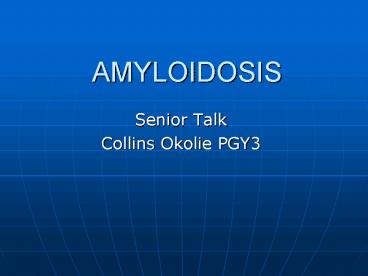AMYLOIDOSIS - PowerPoint PPT Presentation
1 / 22
Title:
AMYLOIDOSIS
Description:
Characteristics common to all amyloid subtypes. Classification. Clinical Importance/Symptoms. Diagnosis and Treatment. Take home message. Definition ... Diagnosis ... – PowerPoint PPT presentation
Number of Views:5162
Avg rating:3.0/5.0
Title: AMYLOIDOSIS
1
AMYLOIDOSIS
- Senior Talk
- Collins Okolie PGY3
2
OBJECTIVES
- Definition
- Mechanism of formation
- Characteristics common to all amyloid subtypes
- Classification
- Clinical Importance/Symptoms
- Diagnosis and Treatment
- Take home message
3
Definition
- A medical condition resulting from aggregation of
extracellularly deposited abnormal proteins
called amyloid fibrils that cause damage to
organs and tissues. - These fibrils are insoluble, linear, rigid and
measures approximately 7.5 to 10mm in width
4
Mechanism of formation
- Amyloid fibrils arise from misfolded proteins.
Alpha helix to beta pleated sheet - Proteins are deposited extracellularly
- Proteins aggregate and form fibrils called
amyloid fibrils. - Misfolded proteins may result from point
mutations. - Deposited as localized vs systemic
- -localized close to cells producing it.
- -Systemic distant sites from these cells
producing these abnormal proteins.
5
- In 1854 Rudolph Virchow named it amyloid based on
color after staining these proteins with iodine
and sulfuric acid. Meaning cellulose or starch
6
Characteristics common to all amyloid subtypes
- Hematoxylin and Eosin (HE) staining results in
amorphous eosinophilic appearance when viewed on
light microscopy.
7
- Amorphous eosinophilic interstitial amyloid
observed on renal biopsy - Picture was adapted from Bruce A Baethge.
Amyloidosis Overview. www.emedicine.medscape.com
8
- Congo red staining results in bright green
fluorescence/birefringe apple green color when
viewed under polarized light.
9
- Congo red staining of a cardiac biopsy specimen
containing amyloid, viewed under polarized light - Picture was adapted from Bruce A Baethge.
Amyloidosis Overview. www.emedicine.medscape.com
10
- Electron microscopy shows regular fibrillar
structure - X-ray diffraction shows beta pleated sheet
structure
11
Classification Historical vs Modern
- Historical (Clinical) Primary, Secondary,
multiple myeloma associated, Familial. - Modern (Biochemical) Since 1960s based on
ability to solubilize fibrils and immunostain for
protein subtypes. - 23 different human subtypes named based on A for
amyloid followed the precursor protein e.g AL,
AH.
12
Table was adapted from Harrison's principles of
internal medicine 16th edition vol II, chapter
310-Amyloidosis
13
Further Clinical Manifestations
- CNS/Neuro Neuropathy both autonomic and
peripheral, dementia. Corneal deposits also. - Cardiac
- -Cardiomyopathy typically restrictive
- -Heart failure predominantly right sided
- -Angina
- -Sudden death
- -Syncope/pre-syncope
- -ECG Abnormalities and Conduction disease
- -Arrhythmia
- -Cardiac tamponade occasionally, though uncommon.
- -Hypotension
14
CARDIAC AMYLOID
Adapted from K. Shah et al, Archives of internal
medicine 2006.
15
- Pulmonary
- -Pleural effusions
- -Parenchymal nodules
- -Tracheal and bronchial infiltration causing
hoarseness, airway obstruction and dysphagia. - Renal Proteinuria, nephrotic syndrome, renal
failure leading to kidney transplant or dialysis.
16
- Heme Bleeding abnormalities
- Musc Hypertrophy of muscles, macroglossia
- Skin Nodules, plaques, easy bruising
- GI Organomegaly (Hepatomegaly, splenomegaly),
gastroparesis, abnormal bowel movement usually
constipation, malabsorption
17
Liver amyloid
Adapted from www.google.com/liver amyloid images
18
Diagnosis
- Unexplained medical disorder and you suspect
amyloidosis e.g heart failure, proteinuria,
hepatic dysfunction - Check ECG, TTE, BNP, UPEP, SPEP
- Ultimately, you need Tissue biopsy Abd fat pad,
rectal, salivary gland, endomyocardium. - Bone marrow biopsy
19
Treatment
- Treatment of this medical disorder is limited and
research is still in progress. - Treatment differs depending on subtype.
- AL and AH
- -High dose mephalan plus dexamethasone/prednisone
- -In selected candidates autologous stem cell
transplant is an option. - - The goal with treatment is to get rid of clonal
plasma cells that lead to immunoglobulin protein
20
- AA Treat the infection or chronic inflammatory
condition causing apo serum A protein elevation. - Familial Mediterranean fever Colchicine
- Other conditions are treated conservatively or
require organ transplant - Prognosis is poor with this medical disorder.
21
TAKE HOME MESSAGE
- Can affect any organ system
- Hematoxylin and Eosin (HE) and Congo stain only
tells you these are amyloid fibrils - Need to immunostain to determine subtype
- Different subtypes are treated differently.
- A lot still have to be known about the therapy as
prognosis is poor for this disease.
22
References
- Rajkumar, S. V. and M. A. Gertz. Advances in
the Treatment of Amyloidosis. NEJM. 2007.
356 2413-2415 - Merlini G and V Bellotti. Molecular Mechanisms of
Amyloidosis. New England Journal of Medicine
2003, August 349583 - Baethge B. Amyloidosis Overview.
www.emedicine.medscape.com - Bogov B, Lubomirova M and Kiperova B. Biopsy of
subcutaneous fatty tissue for diagnosis of
systemic amyloidosis. Hippokratia. 2008
Oct12(4)236-9. - Dember LM. Modern Treatment of Amyloidosis
Unresolved questions. J Am Soc Nephrol. 2008 Dec
10. - Gorevic, Shah, K. B., et al. Amyloidosis and the
Heart. Archives of Internal Medicine. 2006.
166 1805-1813. - P. D. An overview of amyloidosis. UpToDate.com
- J D Sipe and Alan Cohen. Amyloidosis. Harrisons
Principles of Internal Medicine. Chapter 30, page
2024 - Images and tables were obtained from Harrisons,
Archives of internal medicine, emedicine and
google as sited on each image.

